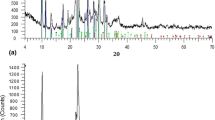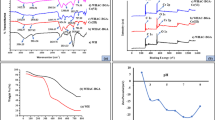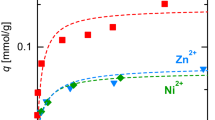Abstract
Heavy metal ions in aqueous media are highly toxic even in minor quantity, and their removal from solution is considered as one of the serious issues in wastewater treatment. Cr(VI) in aquatic environment is a persistent challenge due to its mobility and severe toxicity. A coal-derived activated carbon (AC) with high surface area (3452.8 m2g−1) is prepared and explored for Cr(VI) ion elimination from water. The used and unused AC is characterized through FT-IR, SEM, XRD, TGA, TEM, zeta potential and BET. Maximum uptake (194 mgg−1) of Cr(VI) ions was attained from acidic medium. Values of the thermodynamics models such as ∆G,∆H, ΔS were − 15.54 kJ mol−1, 32.74 kJ mol−1, and 161.95 J mol−1 K−1, respectively, show its spontaneous and endothermic nature. The obtained data show well applicability to D–R, Langmuir, and Freundlich models. The mass transfer of Cr(IV) is regulated by the pseudo-second-order kinetic model. The DFT analyses show that the activated carbon immensely senses and adsorbs the Cr(VI) from the prepared synthetic solutions. Larger negative adsorption energy values depicted the energetically favorable chemisorption nature of the process. The atom in molecule theory provides evidence of hydrogen bonding/weak van der Waals forces during adsorption. Total density of states analysis reveals that AC can be used efficiently for Cr(VI) removal from synthetic and real contaminated solutions.









Similar content being viewed by others
References
Acelas N, Flórez E (2019) Density functional theory studies of the adsorption of Cr (VI) on Fe-(hydr) oxide: Gibbs free energies and ph effect. J Phys Conf Series 1247:012051
Ahmad R, Saeed MM, Ali A, Zaidi JH (2007) Removal of Tm (III) ions from aqueous solution using pan-incorporated sol–gel matrices. Radiochim Acta 95(8):451–457
Ahmad A, Imani A, Mao L, Iqbal R, Zhang H, Ghazi ZA, Ahmad R, Khan AA, **e L, Chen CM (2019) A bifunctional and free-standing organic composite film with high flexibility and good tensile strength for tribological and electrochemical applications. Adv Mater Technol 4(10):1900617
Ali Z, Ahmad R, Khan A (2014) Functionalized nanospheres for efficient sequestration of Cadmium ions. RSC Adv 4(91):50056–50063
Ali Z, Khan A, Ahmad R (2015) The use of functionalized aerogels as a low level chromium scavenger. Micropor Mesopor Mater 203:8–16
Ali Z, Ahmad R, Khan A, Adalat B (2018) Organic-inorganic hybrids: an efficient extractant of environmental mercury ions. Mater Res Expr 5(7):075007
Allen N, Dai C, Hu Y, Kubicki JD, Kabengi N (2019) Adsorption study of Al3+, Cr3+, and Mn2+ onto quartz and corundum using flow microcalorimetry, quartz crystal microbalance, and density Functional Theory. ACS Earth Space Chem 3(3):432–441
Al-Othman ZA, Ali R, Naushad M (2012) Hexavalent chromium removal from aqueous medium by activated carbon prepared from peanut shell: adsorption kinetics, equilibrium and thermodynamic studies. Chem Eng J 184:238–247
Aslani H, Kosari TE, Naseri S, Nabizadeh R, Khazaei M (2018) Hexavalent chromium removal from aqueous solution using functionalized chitosan as a novel nano-adsorbent: modeling and optimization, kinetic, isotherm, and thermodynamic studies, and toxicity testing. Environ Sci Pollut Res 25(20):20154–20168
Ayangbenro A, Babalola O (2017) A new strategy for heavy metal polluted environments: a review of microbial biosorbents. Int J Env Res Public Health 14(1):94
Babel S, Kurniawan TA (2004) Cr (VI) removal from synthetic wastewater using coconut shell charcoal and commercial activated carbon modified with oxidizing agents and/or chitosan. Chemosphere 54(7):951–967
Balamurugan K, Mandal S, Santhosh P, Harish Kumar N (2007) Magnetic and optical properties of Cr2O3 nanoparticles. In: Proceedings of the DAE solid state physics symposium. V. 51
Chang Y, Lai J-Y, Lee D-J (2016) Thermodynamic parameters for adsorption equilibrium of heavy metals and dyes from wastewaters: research updated. Bioresour Technol 222:513–516
Chebeir M, Chen G, Liu H (2016) Emerging investigators series: frontier review: occurrence and speciation of chromium in drinking water distribution systems. Environ Sci: Water Res Technol 2(6):906–914
Chung K-T (1983) The significance of azo-reduction in the mutagenesis and carcinogenesis of azo dyes. Mutat Res/Rev Genet Toxicol 114(3):269–281
Cruz-Olivares J, Pérez-Alonso C, Barrera-Díaz C, Natividad R, Chaparro-Mercado M (2011) Thermodynamical and analytical evidence of lead ions chemisorption onto pimenta dioica. Chem Eng J 166(3):814–821
De Mattos NR, De Oliveira CR, Camargo LGB, da Silva RSR, Lavall RL (2019) Azo dye adsorption on anthracite: a view of thermodynamics, kinetics and cosmotropic effects. Sep Purif Technol 209:806–814
de Oliveira Brito SM, Cordeiro JLC, da Cunha Ramalho L, Oliveira JFR (2019) Eriochrome black adsorption on yellow passion fruit peel (passiflora edulis f Flavicarpa) treated with sodium hydroxide and nitric acid: study of adsorption isotherms, kinetic models and thermodynamic parameters. SN Appl Sci 1(10):1226
Dehghani MH, Taher MM, Bajpai AK, Heibati B, Tyagi I, Asif M, Agarwal S, Gupta VK (2015) Removal of noxious Cr (VI) ions using single-walled carbon nanotubes and multi-walled carbon nanotubes. Chem Eng J 279:344–352
Desta MB (2013) Batch sorption experiments: Langmuir and Freundlich isotherm studies for the adsorption of textile metal ions onto teff straw (eragrostis tef) agricultural waste. J Thermodyn. https://doi.org/10.1155/2013/375830
Dong Z, Chen W, Zheng W, Guzonas D (2013) Effect of yttria addition on the stability of porous chromium oxide ceramics in supercritical water. J Nucl Mater 432(1–3):466–474
Fajarwati F, Anugrahwati M, Yanti I, Safitri R, Yuanita E (2019) Adsorption study of methylene blue and eriochrome black T dyes on activated carbon and magnetic carbon composite. In: IOP conference series: materials science and engineering. IOP Publishing, pp: 012025
Farzaneh F, Najafi M (2012) Synthesis and characterization of Cr2O3 nanoparticles with triethanolamine in water under microwave irradiation. J Sci 22(4):329–333
Fuertes AB, Valle-Vigón P, Sevilla M (2012) One-step synthesis of silica@ resorcinol–formaldehyde spheres and their application for the fabrication of polymer and carbon capsules. Chem Commun 48(49):6124–6126
Guo L-P, Li W-C, Qiu B, Ren Z-X, Du J, Lu A-H (2019) Interfacial assembled preparation of porous carbon composites for selective CO2 capture at elevated temperatures. J Mater Chem A 7(10):5402–5408
Hamadi NK, Chen XD, Farid MM, Lu MG (2001) Adsorption kinetics for the removal of Chromium (VI) from aqueous solution by adsorbents derived from used tyres and sawdust. Chem Eng J 84(2):95–105
Hasany SM, Ahmad R (2006) The potential of cost-effective coconut husk for the removal of toxic metal ions for environmental protection. J Environ Manage 81(3):286–295
Ho Y-S, McKay G (2000) The kinetics of sorption of divalent metal ions onto sphagnum moss peat. Water Res 34(3):735–742
Hu Q, Zhang Z (2019) Application of Dubinin-Radushkevich isotherm model at the solid/solution interface: a theoretical analysis. J Mol Liq 277:646–648
Jain M, Garg VK, Kadirvelu K (2010) Adsorption of hexavalent Chromium from aqueous medium onto carbonaceous adsorbents prepared from waste biomass. J Environ Manage 91(4):949–957
Jan SU, Ahmad A, Khan AA, Melhi S, Ahmad I, Sun G, Chen C-M, Ahmad R (2021) Removal of azo dye from aqueous solution by a low-cost activated carbon prepared from coal: adsorption kinetics, isotherms study, and dft simulation. Environ Sci Pollut Res 28(8):10234–10247
Khan AA, Esrafili MD, Ahmad A, Hull E, Ahmad R, Jan SU, Ahmad I (2019) A computational study on the characteristics of open-shell H-bonding interaction between carbamic acid (nH2 COOH) and HO2, HOS or HSO radicals. J Mol Model 25(7):189
Khan AA, Ahmad R, Ahmad I (2020) Density functional theory study of emerging pollutants removal from water by covalent triazine based framework. J. Mol. Liq. 309:113008
Kim H, Cho HJ, Narayanan S, Yang S, Furukawa H, Schiffres S, Li X, Zhang Y-B, Jiang J, Yaghi OM (2016) Characterization of adsorption enthalpy of novel water-stable zeolites and metal-organic frameworks. Sci Rep 6:19097
Kou L, Frauenheim T, Chen C (2014) Phosphorene as a superior gas sensor: selective adsorption and distinct i–v response. J Phys Chem Lett 5(15):2675–2681
Labied R, Benturki O, Eddine Hamitouche AY, Donnot A (2018) Adsorption of hexavalent Chromium by activated carbon obtained from a waste lignocellulosic material (ziziphus jujuba cores): kinetic, equilibrium, and thermodynamic study. Adsorpt Sci Technol 36(3–4):1066–1099
Li Z, Lu C, **a Z, Zhou Y, Luo Z (2007) X-ray diffraction patterns of graphite and turbostratic carbon. Carbon 45(8):1686–1695
Li H, Gao P, Cui J, Zhang F, Wang F, Cheng J (2018) Preparation and Cr (VI) removal performance of corncob activated carbon. Environ Sci Pollut Res 25(21):20743–20755
Li F, Ahmad A, **e L, Sun G, Kong Q, Su F, Ma Y, Chao Y, Guo X, Wei X (2019) Phosphorus-modified porous carbon aerogel microspheres as high volumetric energy density electrode for supercapacitor. Electrochim Acta 318:151–160
Lipkowski P, Grabowski SJ, Robinson TL, Leszczynski J (2004) Properties of the C−H⊙⊙⊙ H dihydrogen bond: an ab initio and topological analysis. J Phys Chem A 108(49):10865–10872
Lo K-H, Lu C-W, Lin W-H, Chien C-C, Chen S-C, Kao C-M (2020) Enhanced reductive dechlorination of trichloroethene with immobilized clostridium butyricum in silica gel. Chemosphere 238:124596
Manera C, Tonello AP, Perondi D, Godinho M (2019) Adsorption of leather dyes on activated carbon from leather shaving wastes: kinetics, equilibrium and thermodynamics studies. Environ Technol 40(21):2756–2768
Martone N, Rahman GM, Pamuku M, Kingston HS (2013) Determination of chromium species in dietary supplements using speciated isotope dilution mass spectrometry with mass balance. J Agric Food Chem 61(41):9966–9976
Melhi S, Ullah Jan S, Khan AA, Badshah K, Ullah S, Bostan B, Selamoglu Z (2022) Remediation of Cd (II) ion from an aqueous solution by a starch-based activated carbon: experimental and density functional theory (DFT) approach. Crystals 12(2):189
Mella B, Benvenuti J, Oliveira RF, Gutterres M (2019) Preparation and characterization of activated carbon produced from tannery solid waste applied for tannery wastewater treatment. Environ Sci Pollut Res 26(7):6811–6817
Mohan D, Dey S, Dwivedi S, Shukla S (2019) Adsorption of arsenic using low cost adsorbents: guava leaf biomass, mango bark and bagasse. Curr Sci 117(4):00113891
Olha OB, Hovorun DM (2015) New structural hypostases of the A T and G C watson–crick DNA base pairs caused by their mutagenic tautomerisation in a wobble manner: a qm/qtaim prediction. RSC Adv 5(121):99594–99605
Peydayesh M, Bolisetty S, Mohammadi T, Mezzenga R (2019) Assessing the binding performance of amyloid–carbon membranes toward heavy metal ions. Langmuir 35(11):4161–4170
Ponou J, Kim J, Wang LP, Dodbiba G, Fujita T (2011) Sorption of cr (vi) anions in aqueous solution using carbonized or dried pineapple leaves. Chem Eng J 172(2–3):906–913
Prasongkit J, Amorim RG, Chakraborty S, Ahuja R, Scheicher RH, Amornkitbamrung V (2015) Highly sensitive and selective gas detection based on silicene. J Phys Chem C 119(29):16934–16940
Quan C, He Y (2015) Properties of nanocrystalline cr coatings prepared by cathode plasma electrolytic deposition from trivalent chromium electrolyte. Surf Coat Technol 269:319–323
Selvi K, Pattabhi S, Kadirvelu K (2001) Removal of Cr (VI) from aqueous solution by adsorption onto activated carbon. Bioresour Technol 80(1):87–89
Tang L, Thomas AD, Harmon BD (2019) Polyacrylonitrile (pan) polymers with low polydispersity index (pdi) and carbon fibers made therefrom. Google Patents
Tayone J (2015) Spectrophotometric determination of Chromium (VI) in canned fruit juices. Int J Sci: Basic Appl Researchm 19:426–432
Uddin MK (2017) A review on the adsorption of heavy metals by clay minerals, with special focus on the past decade. Chem Eng J 308:438–462
Wan Z, Li M, Zhang Q, Fan Z, Verpoort F (2018) Concurrent reduction-adsorption of chromium using m-phenylenediamine-modified magnetic chitosan: kinetics, isotherm, and mechanism. Environ Sci Pollut Res 25(18):17830–17841
Wei J, Tu C, Yuan G, Bi D, **ao L, Theng BK, Wang H, Ok YS (2019) Carbon-coated montmorillonite nanocomposite for the removal of Chromium (VI) from aqueous solutions. J Hazard Mater 368:541–549
WHO (2017) Guidelines for drinking-water quality: Incorporating first addendum
**e Y, Lin J, Liang J, Li M, Fu Y, Wang H, Tu S, Li J (2019) Hypercrosslinked mesoporous poly (ionic liquid) s with high density of ion pairs: efficient adsorbents for Cr (VI) removal via ion-exchange. Chem Eng J 378:122107
Yang J, Yu M, Chen W (2015a) Adsorption of Hexavalent chromium from aqueous solution by activated carbon prepared from longan seed: kinetics, equilibrium and thermodynamics. J Ind Eng Chem 21:414–422
Yang Y, Zheng F, **a G, Lun Z, Chen Q (2015b) Experimental and theoretical investigations of nitro-group doped porous carbon as a high performance lithium-ion battery anode. J Mater Chem A 3(36):18657–18666
Yuh-Shan H (2004) Citation review of lagergren kinetic rate equation on adsorption reactions. Scientometrics 59(1):171–177
Zhang J, Shao J, ** Q, Li Z, Zhang X, Chen Y, Zhang S, Chen H (2019) Sludge-based biochar activation to enhance Pb (II) adsorption. Fuel 252:101–108
Zhihui L, Rui Z, Yonghua Z, Qian C, Weijun Q (2019) Discriminating wavenumbers selection of ATR-FT-IR spectra for identifying graded asphalt. Constr Build Mater 214:565–573
Author information
Authors and Affiliations
Corresponding author
Ethics declarations
Conflict of interest
The authors declare that they have no conflict of interest.
Additional information
Editorial responsibility: S. Mirkia.
Supplementary Information
Below is the link to the electronic supplementary material.
Rights and permissions
Springer Nature or its licensor (e.g. a society or other partner) holds exclusive rights to this article under a publishing agreement with the author(s) or other rightsholder(s); author self-archiving of the accepted manuscript version of this article is solely governed by the terms of such publishing agreement and applicable law.
About this article
Cite this article
Jan, S.U., Ahmad, A., Khan, A.A. et al. Cr(VI) sequestration by activated carbon: experimental and theoretical study. Int. J. Environ. Sci. Technol. 21, 5557–5568 (2024). https://doi.org/10.1007/s13762-023-05362-1
Received:
Revised:
Accepted:
Published:
Issue Date:
DOI: https://doi.org/10.1007/s13762-023-05362-1




